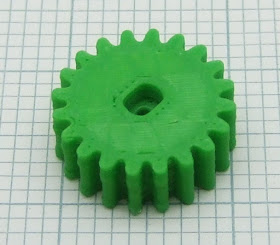The maximum diameter is governed by the hole size and the die swell. The head movement has to be about the same as the rate that the filament leaves the nozzle, or faster, otherwise the filament squirms about and makes a zigzag instead of a straight line. Fortunately the faster the flow rate, the more die swell there is, which works in our favour when trying to extrude the maximum diameter filament. With the 0.5mm nozzle I could extrude up to about 1mm with ABS and I used that to good effect when making the first layer of the raft. With a 0.3mm hole die swell is more but even so I can only get 0.8mm filament. That makes the first raft layer thinner, so it is less tolerant to the bed being uneven.
I normally extrude at a rate that produces filament the same diameter as the nozzle but it can be stretched further making it smaller than the nozzle. The limiting factor is when the filament starts to snap. I did make some 0.3mm filament with the 0.5mm nozzle but I don't think I got the full benefit of the extra resolution because the filament was less constrained as the nozzle changed direction.

These two gears are both made from the same gcode with 0.3mm filament giving a layer height of 0.24mm. The one on the left was made with a 0.5mm nozzle and the one on the right with the new extruder with 0.3mm nozzle. The latter is slightly better defined. The benefit is more apparent on the underside.

The bottom of the one on the left feels perfectly smooth due to being made on a raft with a very fine surface. It is actually smoother than a sample I have from a commercial machine.
I was disappointed that it did not improve the clockwise slant of the teeth. This must be due to the same effect that makes holes come out too small. The filament likes to cut corners, so when the head moves on a curved path the filament takes a smaller radius path. I noticed that the teeth are straight at the base but slanted at the top, so the effect is somewhat cumulative.
I made another one with the outlines anti-clockwise on every second layer. Here is a video of it being made: -
HydraRaptor RepRapping a gear from Nop Head on Vimeo.
The teeth came out straighter but the edges are slightly more ridged because each layer alternates a little.

The surface is not quite as good as the previous one. I put that down to variations in the feed stock diameter. You need exactly the right amount of plastic to get a good surface.
I also need to up the resolution of my z-axis. 0.05mm is significant with 0.24 mm layers, so I will have to add microstepping like my other axes.
So in summary 0.3mm nozzle gives noticeably better results and can still make 0.5mm filament due to die swell. It is harder to get the raft heights and temperatures correct. To get the same build rate with 0.3mm filament I would have to extrude at 44mm/s, but HydraRaptor is currently limited to 32mm/s. I could probably tune it up to 44 but the vibration gets a bit ridiculous as the moving mass of the table is 9Kg.
Does the smaller nozzle significantly increase the time to create the parts?
ReplyDeleteHi Andy,
ReplyDeleteIf I make parts with 0.5mm filament it takes exactly the same time. The same volume of plastic is being pushed through a smaller hole, so it just takes a bit more pressure.
If I make parts with 0.3mm filament then to extrude the plastic at the same rate I would have to speed up the head movement by (0.5/0.3)^2 = 2.8. That would give the roughly the same build speed. In fact I have only doubled the head speed, so it will take 2.8/2 = 1.4 times longer to make something.
I could also use 0.35mm filament and maintain the same build rate.
When I get my Darwin going I hope to be able to do 44mm/s and so get the resolution while keeping the speed.
Holy shit, how fast your machine is.
ReplyDeleteUnbelievable.
Khiraly
There are three very good reasons for that: -
ReplyDeleteThe lead screws are multi start with a pitch of 1/2" so much faster than studding. Darwin is much faster, with belt drive though.
The motors are driven from 24V.
I have acceleration and declaration so I can run faster than the max starting speed.
Those are the best parts I've seeing from a Home made Fdm.
ReplyDeleteAre you using the same abs filament that comercial machines uses?
No I am using 3mm ABS welding rod. I think Stratasys use 2mm ABS, probably with very closely controlled diameter, but they sell it for many times the price.
ReplyDeleteI must of watched your video a dozen times. Brilliant work, Nop.
ReplyDeletehello nophead where I can be able the parts to make the hidraraptor?
ReplyDeleteI got the XY-table on eBay and the Z axis from CNCZone.
ReplyDelete